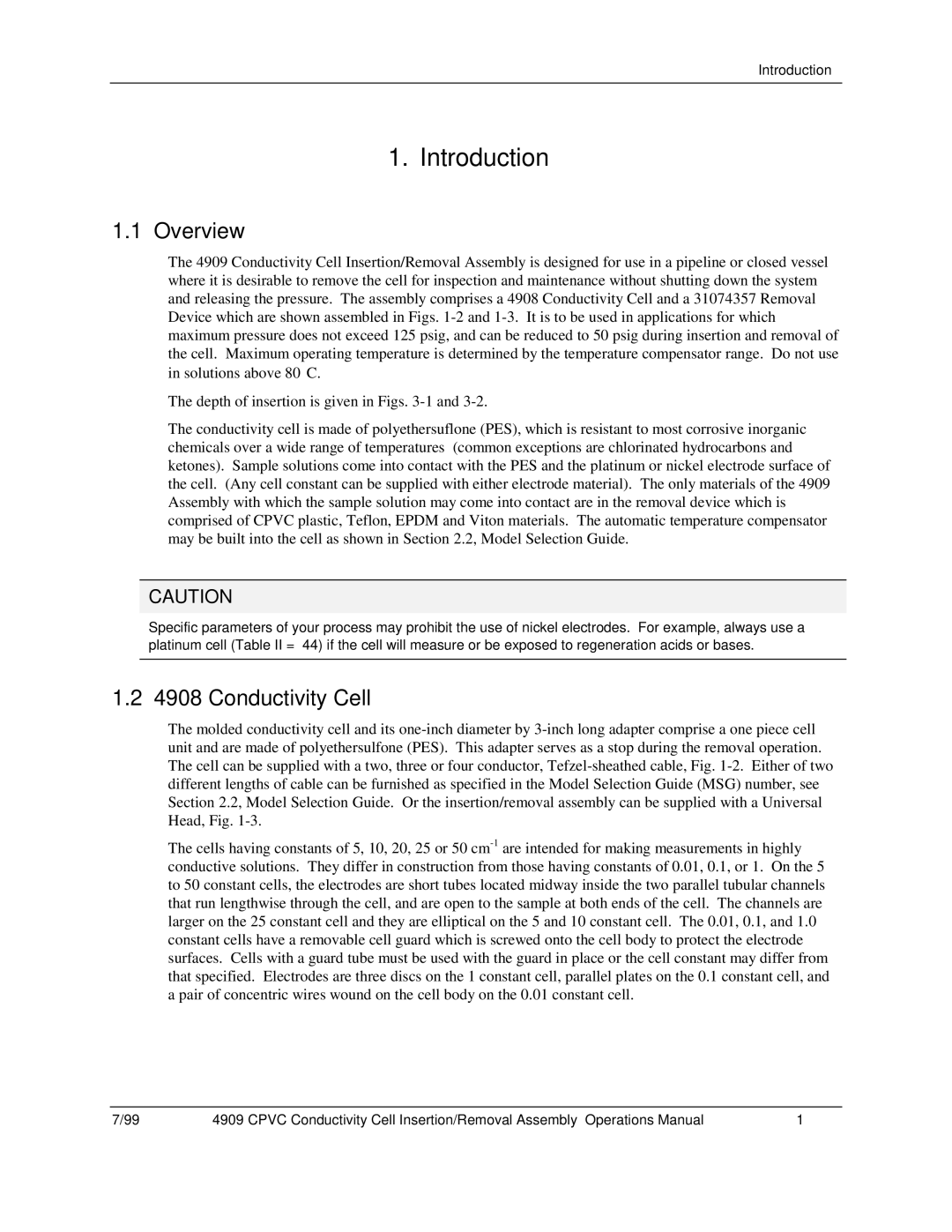Introduction
1. Introduction
1.1 Overview
The 4909 Conductivity Cell Insertion/Removal Assembly is designed for use in a pipeline or closed vessel where it is desirable to remove the cell for inspection and maintenance without shutting down the system and releasing the pressure. The assembly comprises a 4908 Conductivity Cell and a 31074357 Removal Device which are shown assembled in Figs. 1-2 and 1-3. It is to be used in applications for which maximum pressure does not exceed 125 psig, and can be reduced to 50 psig during insertion and removal of the cell. Maximum operating temperature is determined by the temperature compensator range. Do not use in solutions above 80°C.
The depth of insertion is given in Figs. 3-1 and 3-2.
The conductivity cell is made of polyethersuflone (PES), which is resistant to most corrosive inorganic chemicals over a wide range of temperatures (common exceptions are chlorinated hydrocarbons and ketones). Sample solutions come into contact with the PES and the platinum or nickel electrode surface of the cell. (Any cell constant can be supplied with either electrode material). The only materials of the 4909 Assembly with which the sample solution may come into contact are in the removal device which is comprised of CPVC plastic, Teflon, EPDM and Viton materials. The automatic temperature compensator may be built into the cell as shown in Section 2.2, Model Selection Guide.
CAUTION
Specific parameters of your process may prohibit the use of nickel electrodes. For example, always use a platinum cell (Table II = 44) if the cell will measure or be exposed to regeneration acids or bases.
1.2 4908 Conductivity Cell
The molded conductivity cell and its one-inch diameter by 3-inch long adapter comprise a one piece cell unit and are made of polyethersulfone (PES). This adapter serves as a stop during the removal operation. The cell can be supplied with a two, three or four conductor, Tefzel-sheathed cable, Fig. 1-2. Either of two different lengths of cable can be furnished as specified in the Model Selection Guide (MSG) number, see Section 2.2, Model Selection Guide. Or the insertion/removal assembly can be supplied with a Universal Head, Fig. 1-3.
The cells having constants of 5, 10, 20, 25 or 50 cm-1are intended for making measurements in highly conductive solutions. They differ in construction from those having constants of 0.01, 0.1, or 1. On the 5 to 50 constant cells, the electrodes are short tubes located midway inside the two parallel tubular channels that run lengthwise through the cell, and are open to the sample at both ends of the cell. The channels are larger on the 25 constant cell and they are elliptical on the 5 and 10 constant cell. The 0.01, 0.1, and 1.0 constant cells have a removable cell guard which is screwed onto the cell body to protect the electrode surfaces. Cells with a guard tube must be used with the guard in place or the cell constant may differ from that specified. Electrodes are three discs on the 1 constant cell, parallel plates on the 0.1 constant cell, and a pair of concentric wires wound on the cell body on the 0.01 constant cell.

